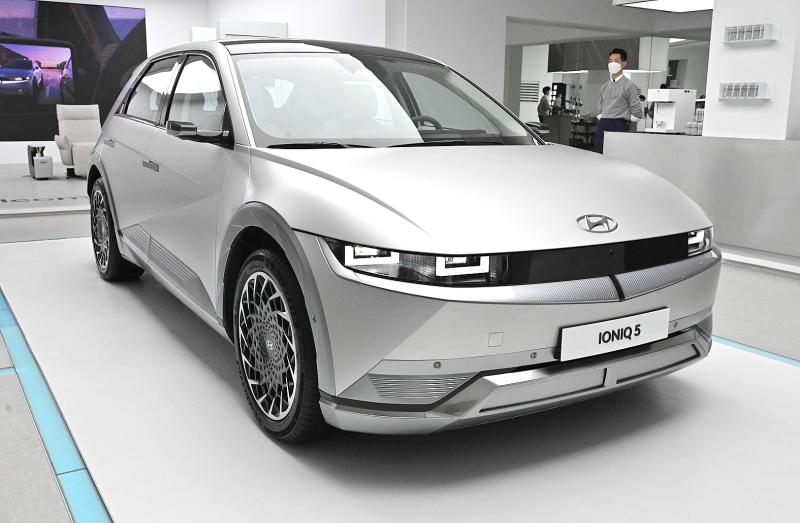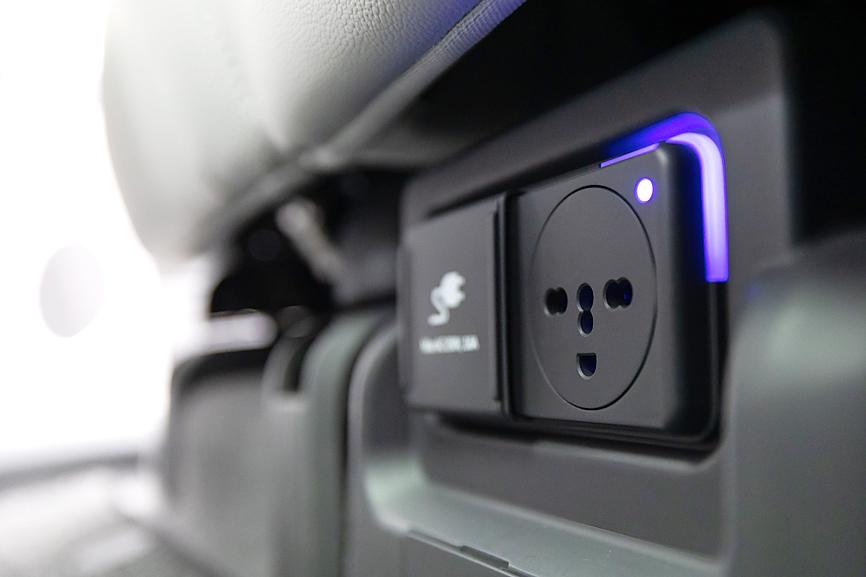Hyundai Motor Co is pitching its new Ioniq 5 as being able to do more than the average electric vehicle (EV).
In a series of promotional videos on YouTube, a camper is shown running on a treadmill hooked up to the vehicle’s battery, listening to their favorite tunes on a bank of speakers and even rustling up a roast chicken dinner in a portable oven.
The vehicle can supply up to 3.6 kilowatts of power, enough to run appliances such as refrigerators and stoves.

Photo: AFP
It is part of a push by Hyundai to appeal to a younger audience as it plays catch-up in the EV market. The South Korean automaker is behind EV pioneers such as Tesla Inc and established brands such as Volkswagen AG and BMW AG, only introducing its electric car in 2016.
“We looked at the wider meaning of space that would include outdoor and daily activities that consumers can do with their cars,” Heung Soo-kim, a senior vice president and head of product and EV businesses at Hyundai, said in an interview last month. “We are constantly looking into new features that will appeal to users.”
Hyundai said that it is the first major EV maker to offer bi-directional charging, which means owners can power electronic devices from the vehicle battery. While conventional vehicle batteries can be used to charge laptops and phones, they drain quickly if hooked up to anything more powerful, such as a portable fridge or sound system, meaning serious campers need to install a dual-battery system or lug around heavy, noisy generators to power their home comforts.

Photo: Bloomberg
The Ioniq 5 also comes with the option to install a solar-panel roof that would charge the battery pack, giving the vehicle an additional driving range of about 1,300km annually.
US-based EV start-up Rivian Automotive Inc is also looking to attract buyers who love the great outdoors, but with some creature comforts. It has developed a slide-out camp kitchen for its Sedona SUV complete with an induction cooktop powered by the vehicle battery.
Hyundai in the next few months is set to start sales of the Ioniq 5, its first EV built on a dedicated platform called the Electric-Global Modular Platform, or E-GMP. The flattened chassis allows the automaker to create more spacious interiors, another drawcard to entice drivers to switch from convention gasoline-powered vehicles.
“This year will be the start of a new era for Hyundai and Kia as its full EVs go on sale,” said Lee Jae-il, an analyst at Eugene Investment & Securities Co in Seoul. “Hyundai has come a long way from being one of the latecomers to the EV market to offering a very competitive product with the Ioniq 5.”
Still, demand for the Ioniq 5 is expected to be slow initially. Hyundai received orders for just more than 20,000 of the vehicles in South Korea on the day pre-orders opened. The automaker aims to sell 26,500 of the EV model in its home market this year, a fraction of its total sales target of 741,500 vehicles.
The Ioniq 5 is to start at 52 million won (US$46,382) before subsidies, Hyundai’s Web site said.
The smaller Kona EV starts at 49 million won before subsidies, and its Palisade sports utility vehicle starts at 36.4 million won.
Another feature Hyundai said sets it apart from rivals is its charging speed. The platform enables EVs to charge up to 80 percent capacity from 10 percent in 18 minutes and add as much as 100km of driving range in just five minutes. They would have a top range of 500km on a single charge.
The vehicles would also charge at 800 volts and 400 volts, giving owners to access more charging infrastructure, Kim said.
That compares with Volkswagen’s ID.4, which takes about 38 minutes to charge up to 80 percent from 5 percent in about 38 minutes and add 100km in about 10 minutes. It falls short of the Porsche Taycan, which can add enough charge for 100km in four minutes, and has a total range of 450km. Tesla markets the long-range version of its Model 3 at about 515km.
Hyundai’s Kia Corp unit last month also unveiled its new EV6 model that would be assembled on the same E-GMP platform and is expected to go on sale in July.
“We also focused on having a modular platform that will enable us to offer various types of vehicles on the same platform,” Kim said.
Hyundai is also working to build charging infrastructure to encourage more people to buy EVs. The conglomerate last month unveiled plans to provide ultra-high-speed charging stations through its E-pit brand. It plans to open 20 stations in South Korea this year and to work with potential partners overseas to build the infrastructure.
Emerging markets beckon, too, with India and Southeast Asia part of the company’s long-term strategy, Kim said.
Hyundai is also considering partnerships with local governments to build charging infrastructure to support demand for EVs, he said.

BYPASSING CHINA TARIFFS: In the first five months of this year, Foxconn sent US$4.4bn of iPhones to the US from India, compared with US$3.7bn in the whole of last year Nearly all the iPhones exported by Foxconn Technology Group (富士康科技集團) from India went to the US between March and last month, customs data showed, far above last year’s average of 50 percent and a clear sign of Apple Inc’s efforts to bypass high US tariffs imposed on China. The numbers, being reported by Reuters for the first time, show that Apple has realigned its India exports to almost exclusively serve the US market, when previously the devices were more widely distributed to nations including the Netherlands and the Czech Republic. During March to last month, Foxconn, known as Hon Hai Precision Industry

Taiwan Semiconductor Manufacturing Co (TSMC, 台積電) and the University of Tokyo (UTokyo) yesterday announced the launch of the TSMC-UTokyo Lab to promote advanced semiconductor research, education and talent development. The lab is TSMC’s first laboratory collaboration with a university outside Taiwan, the company said in a statement. The lab would leverage “the extensive knowledge, experience, and creativity” of both institutions, the company said. It is located in the Asano Section of UTokyo’s Hongo, Tokyo, campus and would be managed by UTokyo faculty, guided by directors from UTokyo and TSMC, the company said. TSMC began working with UTokyo in 2019, resulting in 21 research projects,

Taiwan’s property market is entering a freeze, with mortgage activity across the nation’s six largest cities plummeting in the first quarter, H&B Realty Co (住商不動產) said yesterday, citing mounting pressure on housing demand amid tighter lending rules and regulatory curbs. Mortgage applications in Taipei, New Taipei City, Taoyuan, Taichung, Tainan and Kaohsiung totaled 28,078 from January to March, a sharp 36.3 percent decline from 44,082 in the same period last year, the nation’s largest real-estate brokerage by franchise said, citing data from the Joint Credit Information Center (JCIC, 聯徵中心). “The simultaneous decline across all six cities reflects just how drastically the market

Ashton Hall’s morning routine involves dunking his head in iced Saratoga Spring Water. For the company that sells the bottled water — Hall’s brand of choice for drinking, brushing his teeth and submerging himself — that is fantastic news. “We’re so thankful to this incredible fitness influencer called Ashton Hall,” Saratoga owner Primo Brands Corp’s CEO Robbert Rietbroek said on an earnings call after Hall’s morning routine video went viral. “He really helped put our brand on the map.” Primo Brands, which was not affiliated with Hall when he made his video, is among the increasing number of companies benefiting from influencer